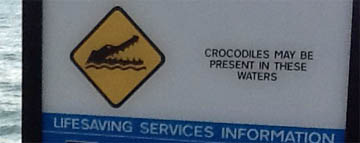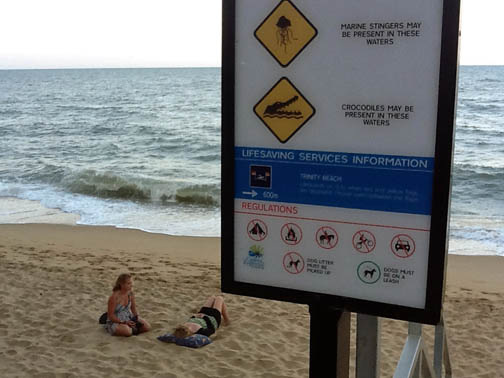Danger Down Under (Australian National Parks)
J. William T. Youngs
October 5, 2012
Later this week History 498 will be on the road again, this time in far-away Australia. While I’m there (for two weeks) I’ll be visiting several national parks and watching a total eclipse of the sun. I will of course continue teaching our class, and you will of course continue your great work on discussions and quizzes. Additionally I should be able to post new “Fireside Talks” with an Australian perspective on important themes in our class.
The reason for my going on this journey started with a trip last year to Columbia Basin College with a friend, Jay Pasachof, an expert on solar eclipses. He was visiting the astronomical observatory at CBC and giving a talk on solar eclipses. Jay is a college classmate of mine, and while I’ve been studying and teaching history he has been studying astronomy, writing three Peterson Field Guides on the subject and observing about 50 total eclipses of the sun. He had arranged a tour to Australia with the eclipse as one focal point and some park visits as another. I decided to go along, expecting that the journey would dovetail nicely with my goals in teaching “The History of the American National Parks” while visiting as many parks as possible.
So that is the “back story.”
As I’m getting ready for the trip, I’ve been looking at descriptions of places I’ll visit, starting with Port Douglas on the northeast coast of Australia, near Cairns, where we will see the total eclipse. As a park-watcher, this sentence in the description of Port Douglas caught my eye: “It is the only place on earth where two World-Heritage-listed jewels exist: the Great Barrier Reef and the rainforest of Daintree and Cape Tribulation.”
Wow!
These questions, among others, come to mind:
What exactly is a World Heritage Site?
How are these parks administered?
What are the notable differences between these Australian national parks and our parks, in terrain, origin, and governance?
One thing I’ve noticed in the tour description is an emphasis on danger. A wilderness is not a wilderness without some danger, right?! One of our stops will be at “Hartley’s Crocodile Adventures.” Here’s the descrition:
It’s an award winning eco-adventure park set in World Heritage surroundings. Get incredibly close to crocodiles! Enjoy the jumping crocodiles on our boat cruise around our naturally beautiful lagoon, watch the awesome crocodile attack show, plus check out our fascinating and informative shows on snakes, koalas, and cassowaries.
Well, I don’t know what a cassowary is, but I do know that I don’t want to get incredibly close to any crocodiles! (We are also being promised the opportunity to see the “crocodile death roll.”) Then, of course, Truman C. Everts did not want to get lost in Yellowstone, and Glen and Bessie Hyde did not want to go missing in the Grand Canyon! And speaking of “going missing,” that is a phrase that comes up several times in the tour literature, as in, be careful that you stay on the trails in the rain forest because people who don’t have “gone missing” – presumably never to return.
I might have dismissed my own crocodile prejudices as unwarranted, but yesterday (Sunday, November 5, 2012) our astronomer, Jay Pasachoff, who is already in Australia setting up his eclipse-watching equipment, sent us an email with this picture of the beach near where we will be staying:
October 5, 2012
Later this week History 498 will be on the road again, this time in far-away Australia. While I’m there (for two weeks) I’ll be visiting several national parks and watching a total eclipse of the sun. I will of course continue teaching our class, and you will of course continue your great work on discussions and quizzes. Additionally I should be able to post new “Fireside Talks” with an Australian perspective on important themes in our class.
The reason for my going on this journey started with a trip last year to Columbia Basin College with a friend, Jay Pasachof, an expert on solar eclipses. He was visiting the astronomical observatory at CBC and giving a talk on solar eclipses. Jay is a college classmate of mine, and while I’ve been studying and teaching history he has been studying astronomy, writing three Peterson Field Guides on the subject and observing about 50 total eclipses of the sun. He had arranged a tour to Australia with the eclipse as one focal point and some park visits as another. I decided to go along, expecting that the journey would dovetail nicely with my goals in teaching “The History of the American National Parks” while visiting as many parks as possible.
So that is the “back story.”
As I’m getting ready for the trip, I’ve been looking at descriptions of places I’ll visit, starting with Port Douglas on the northeast coast of Australia, near Cairns, where we will see the total eclipse. As a park-watcher, this sentence in the description of Port Douglas caught my eye: “It is the only place on earth where two World-Heritage-listed jewels exist: the Great Barrier Reef and the rainforest of Daintree and Cape Tribulation.”
Wow!
These questions, among others, come to mind:
What exactly is a World Heritage Site?
How are these parks administered?
What are the notable differences between these Australian national parks and our parks, in terrain, origin, and governance?
One thing I’ve noticed in the tour description is an emphasis on danger. A wilderness is not a wilderness without some danger, right?! One of our stops will be at “Hartley’s Crocodile Adventures.” Here’s the descrition:
It’s an award winning eco-adventure park set in World Heritage surroundings. Get incredibly close to crocodiles! Enjoy the jumping crocodiles on our boat cruise around our naturally beautiful lagoon, watch the awesome crocodile attack show, plus check out our fascinating and informative shows on snakes, koalas, and cassowaries.
Well, I don’t know what a cassowary is, but I do know that I don’t want to get incredibly close to any crocodiles! (We are also being promised the opportunity to see the “crocodile death roll.”) Then, of course, Truman C. Everts did not want to get lost in Yellowstone, and Glen and Bessie Hyde did not want to go missing in the Grand Canyon! And speaking of “going missing,” that is a phrase that comes up several times in the tour literature, as in, be careful that you stay on the trails in the rain forest because people who don’t have “gone missing” – presumably never to return.
I might have dismissed my own crocodile prejudices as unwarranted, but yesterday (Sunday, November 5, 2012) our astronomer, Jay Pasachoff, who is already in Australia setting up his eclipse-watching equipment, sent us an email with this picture of the beach near where we will be staying:
Now, I don’t know about you, but for me, the pleasure of swimming in that warm water would be greatly diminished by the knowledge that I might be sharing the surf with a crocodile!
FOOD FOR THOUGHT
To what extent does danger (apparent or real) enhance a wilderness experience?
FOOD FOR THOUGHT
To what extent does danger (apparent or real) enhance a wilderness experience?


